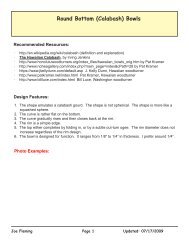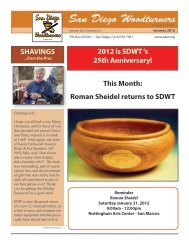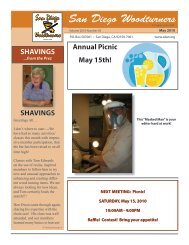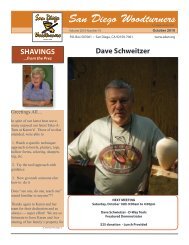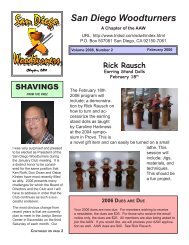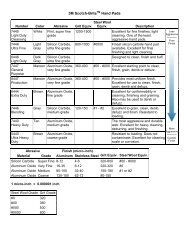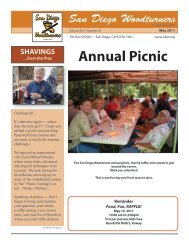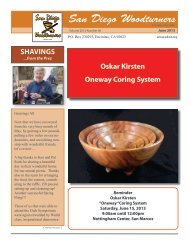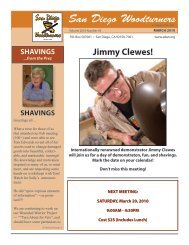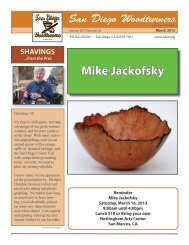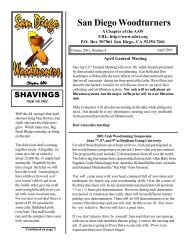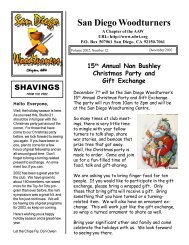March - San Diego Woodturners
March - San Diego Woodturners
March - San Diego Woodturners
Create successful ePaper yourself
Turn your PDF publications into a flip-book with our unique Google optimized e-Paper software.
<strong>San</strong> <strong>Diego</strong> <strong>Woodturners</strong> Page 11 <strong>March</strong> 2011<br />
(Joe Fleming - continued from page 10)<br />
• Deft Lacquer at Home Depot can require 30<br />
coats<br />
• Frisket Masking Paper, Spray, or Liquid –<br />
matte finish; online<br />
Reference books mentioned are:<br />
• The Wood <strong>San</strong>ding Book – <strong>San</strong>dor Nagyszalanczy<br />
• Understanding Wood Finishing – Bob<br />
Flexner<br />
• Decorating Turned Wood – Liz & Michael<br />
O’Donnell<br />
• Color Mixing Bible – Ian Sidaway<br />
• Fine Woodworking #169: Spraying Basics<br />
• How to Mix and Use Color – Tony Paul<br />
• Blick Art Materials – dickblick.com<br />
• Tri-City Paints, <strong>San</strong> <strong>Diego</strong>: spray painting<br />
supplies<br />
Joe’s highlighted coloring technique is the Don<br />
Deery high gloss method for all woods except burls,<br />
which have too many grain imperfections for a high<br />
gloss finish:<br />
1. <strong>San</strong>ding: stop at 180 or 220 grit; higher grits<br />
will fill wood pores and prevent color penetration; if<br />
desired, use wood filler to fill pores<br />
2. Spritz the surface to see grain pattern and<br />
imperfections<br />
3. Bleach if desired; use disposable brushes; the<br />
wood color will lighten only after the bleach dries;<br />
repeat bleaching if desired; Joe’s recommendation is<br />
as light as possible and at least three bleachings<br />
4. Lacquer seal coat the surface lightly, leaving<br />
deep pores open for color<br />
5. Grain-filling with Color (optional): rub in<br />
colorant; when dry, lightly sand to lacquer layer,<br />
leaving color in deeper pores; make sure that the fill<br />
effect is even over the entire surface of the vessel<br />
6. Top Coats: top coat color with two coats<br />
of sanding sealer; minimum of five coats of spray<br />
lacquer, sanding after all lacquer layers are applied<br />
to remove shiny dimples, using up to 400 or 600 grit<br />
7. Buffing: use the four step Meguiar process,<br />
meguiarsdirect.com<br />
The lacquer and color can be spray painted if desired<br />
for better control than a piece of cloth. Spraying<br />
also allows blending and banding of colors. Equipment<br />
choices:<br />
• Iwata Air Brush equipment: iwata-medea.<br />
com<br />
• HVLP – High Volume Low Pressure systems<br />
• Air compressors generate water, so use an<br />
in-line water separator<br />
After all the hard work is finished, preserve the colors<br />
by keeping the artwork out of sunlight. Exposure<br />
to sunlight will eventually fade the colors, even<br />
if they are top coated.<br />
• Metal acid dyes are the most durable, but<br />
have limited color selections<br />
• Water based colors have the next highest<br />
resistant to fading and are the recommended choice<br />
• Alcohol based colors are not as color fast as<br />
water based<br />
Practice on scrap pieces of the same type of wood<br />
first. Note the differences between sanding grits,<br />
bleaching, colors – blue turns teal, red turns orange.<br />
Popular wood stays green even after bleaching.<br />
Walnut bleaches well; using red on bleached Walnut<br />
highlights the red color; Maple also works well.<br />
If you have any questions, Joe Fleming is available<br />
as a “coloring” mentor.



